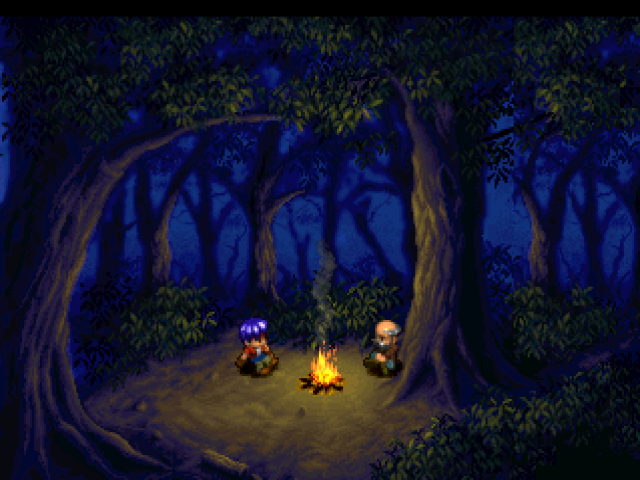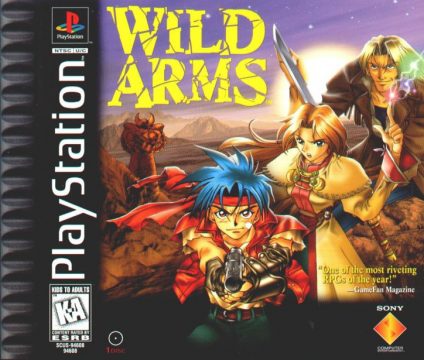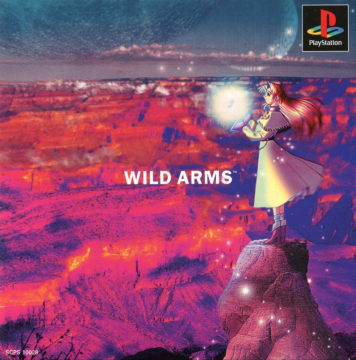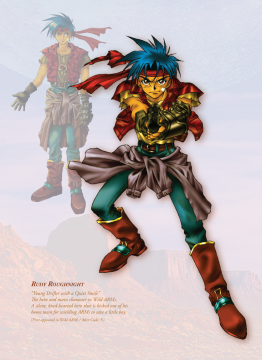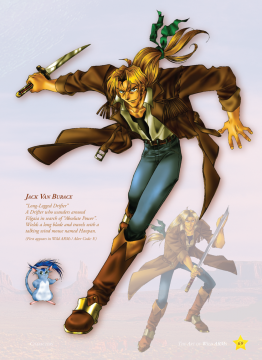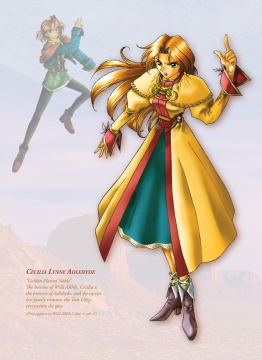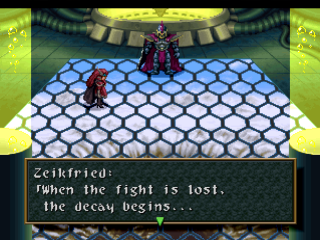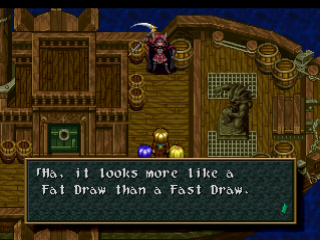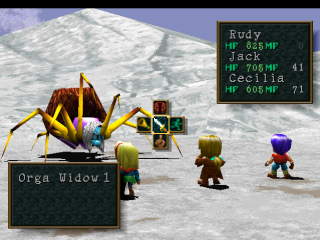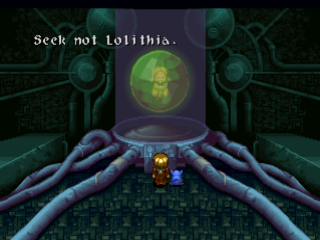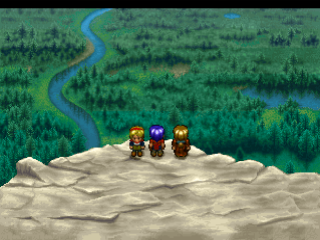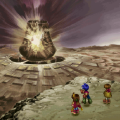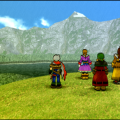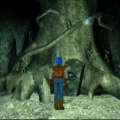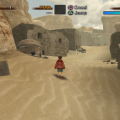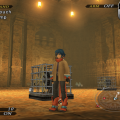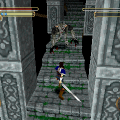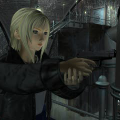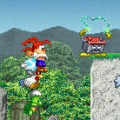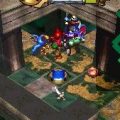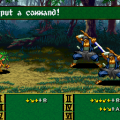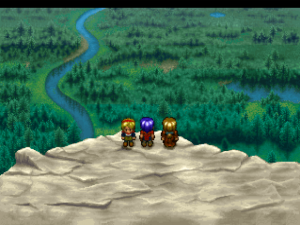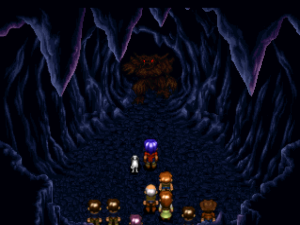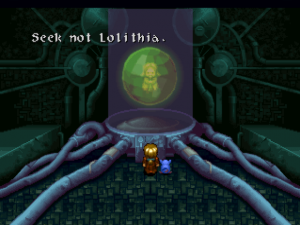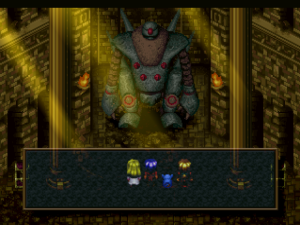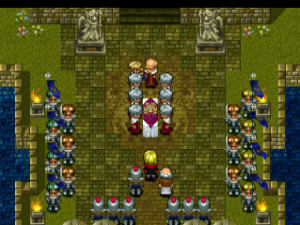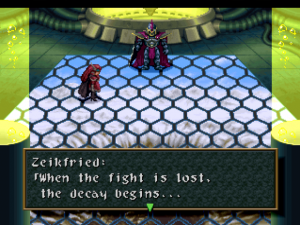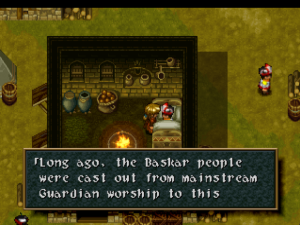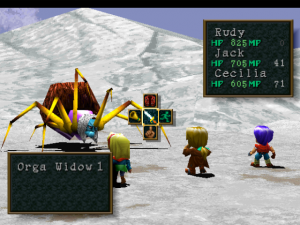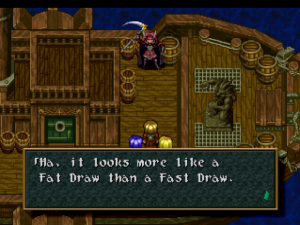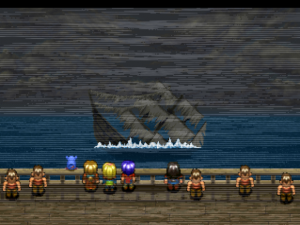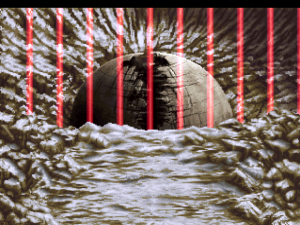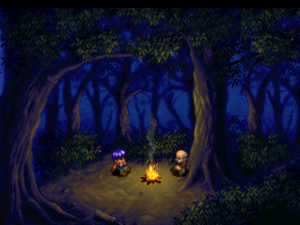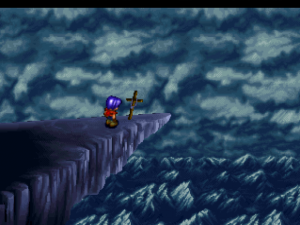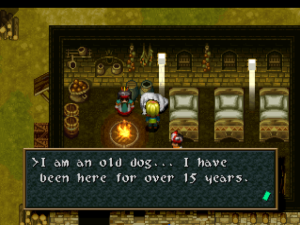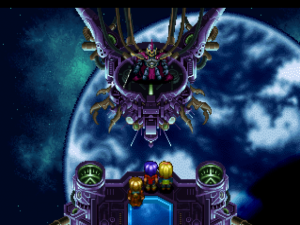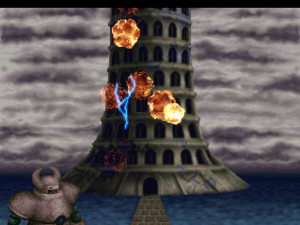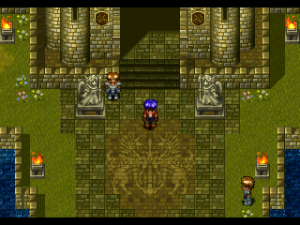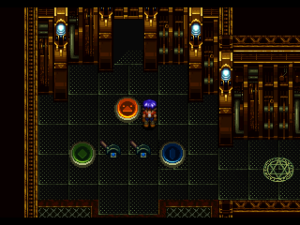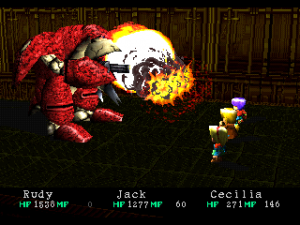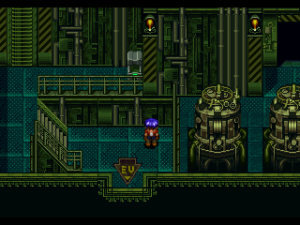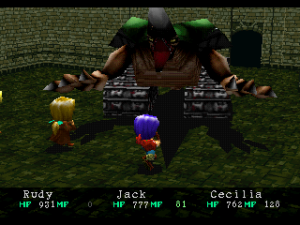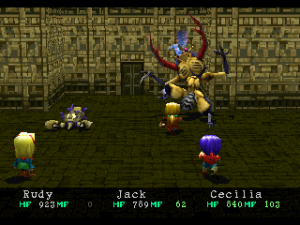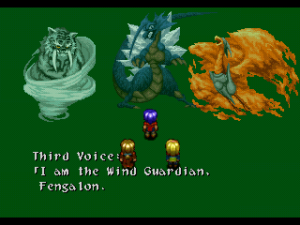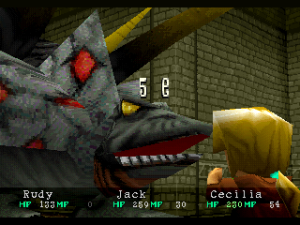Square and Enix were to the two juggernauts of Japanese RPGs in the 1990s, thanks to Final Fantasy and Dragon Quest. But before those two flagship franchises were slow to appear on the Sony PlayStation, released in Japan in 1994 and America in 1995, which needed some representation in the genre. This allowed space for some lower budget releases to make it into the market, the most notable being Camelot’s Beyond the Beyond, Konami’s Suikoden, and Sony’s Wild ARMs.
Considered against its successors, the original Wild ARMs is modest in scope. But where every sequel is thrown off balance by its flaws, the original is exactly what it wants to be: An uncomplicated mid-sized JRPG that stands out thanks to its unconventional wild west aesthetic.
Wild ARMs is the story of three protagonists. At the beginning, you can choose to play each of their stories, which act as prologues, before the trio eventually meet and the real adventure begins.
Characters
Rudy Roughknight
A silent boy with blue hair and a mysterious past.
Jack Van Burace
A power-hungry treasure hunter who ALSO harbors a mysterious past. He’s joined by his partner-in-crime, a magical mouse named Hanpan.
Cecilia Adlehyde
The princess of the kingdom of Adlehyde and a magician-in-training.
After their intro sequences (a commonality among Wild ARMs games), these three unite to help an archaeologist/engineer named Emma excavate a golem, which is an artifact from a world-shattering event called the Demon Wars, which happened a thousand years’ prior to the start of the game. Once they obtain the golem, it is put on display at a festival in Adlehyde. Tragically, demons break through the sky and attack during the festival, stealing the golem. The demons announce their ambition to resurrect their leader and destroy the world. Then they destroy Adlehyde. As good an impetus as they’ll ever get, Rudy, Jack, and Cecilia band together to take down the demon menace.
Developed by the company Media Vision, Wild ARMs was designed with the intent of making a traditional JRPG that incorporates wild west themes alongside anime fantasy conventions. The western vibes are really what draws people into the series. There are similar games in terms of gameplay and narrative, but few if any have a comparable style. The original is actually one of the more grounded of the series aesthetically, veering more toward traditional medieval European-style fantasy than the others. Still, it has enough of an edge to make it stand out among the PSX’s library.
Wild ARMs introduces many of the series’ setpieces. Most important is the setting of Filgaia: A dying desert planet that gives the series its wild west sheen. There is some light historical continuity between each entry, but it’s more thematic than narrative—it’s only slightly evident that they exist within the same universe. If they do, they are likely set thousands of years apart. (There are character cameos in Wild ARMs 5 to celebrate the series’ tenth anniversary, but these are for fanservice rather than to establish continuity, as every games’ characters existing simultaneously would make no sense.) Filgaia itself also looks very different in each game, in varying states of ecological devastation and in the shape of its landmasses, which suggests either a different universe or a different era. Wild ARMs 3 does reintroduce some villains from the original, so the latter is most likely.
Within Filgaia there are many other recurring features. The Elw (El-loo) are the requisite ancient civilization, and their temples allow for early-game fast travel across continents before you get other means of transportation. The weapons known as ARMs are of course present throughout the series, though their significance is inconsistent—in Wild ARMs they are an ancient technology that most people fear and few can wield, but in other games in the series people use them with no problem or stigma. In Wild ARMs 3, every playable character uses an ARM. ARMs itself ostensibly stands for “Ancient Relic Machines,” though this acronym only applies to the first game.
One of the more interesting series mainstays is the Baskar tribe, which are a Native American analogue. There’s typically only one Baskar Village in each game, but they always have a fairly sizable place in the story. Wild ARMs 2 and 3 have playable Baskar characters, which aside from Shadow Hearts 3: From the New World are some of the only playable Native-equivalent characters in JRPG-dom. (Though, interestingly, the Baskar tribe in Wild ARMs 2 is portrayed as white, but that’s a discussion for later.)
Wild ARMs games are noted for their intricate puzzles, which rely on the use of various tools. The series can be thought of as a successor to Natsume’s Lufia series. Each character in the original gains four tools throughout the game: Rudy gets Bombs, a Radar, Skates, and a Power Glove; Jack gets Hanpan, a Lighter, a Grappling Hook, and a Guitar; Cecilia gets her Teardrop, a Pocket Watch, a Magic Rod, and a Water Vase
This is the most tools-per-character in any ARMs game. Some of them aren’t even used for puzzles. The Guitar is used for summoning monsters and the Radar is used for locating treasures. But they all typically prove useful in the game’s dungeons. The original game doesn’t have any especially difficult puzzles, but they are more challenging, varied and smoothly incorporated than many of the game’s contemporaries. Some require speed and hand-eye coordination that one doesn’t typically see in turn-based RPGs. One unfortunate aspect of the puzzles is that you are often solving them while simultaneously dealing with random encounters, which can make it tedious. A magic spell that decreases the encounter rate helps a little, but you only get access to it late in the game. Graciously, future games in the series introduce a system to cancel encounters before they occur, somewhat alleviating the annoyance.
Battles in Wild ARMs have just enough little tricks and nuances past the typical mechanics to keep you engaged. Each character has a unique special skill set. Rudy wields ARMs, which cause powerful attacks but are limited by your bullet supply. Reloading is available solely in towns and via the scarce Bullet Load item. ARMs can be upgraded for power, accuracy, and bullet capacity, though these upgrades get expensive quickly. The most expensive upgrades are 65,000 gella, some of the highest-priced purchases in the game. Each gun is found throughout the world in unique chests, often off the beaten path and requiring tools or duplicators (rare magic keys that are also commonly used throughout the series) to access.
Jack uses Quick Draw, a swordfighting technique tied to his backstory that emphasizes speed. When using these skills, he’ll almost inevitably be the first to act. He picks up Quick Draws by coming across various triggers that give him an idea for a skill. For instance, one of the first he picks up is triggered by walking across a windy corridor on a mountain pass. Once the skill has been triggered, however, Jack still has to “learn” it by using it over and over again until it activates, a bit like the glimmer system in the SaGa series. Until it activates, the skill is shown as a series of question marks in the menu. If you use the “?????” skill and it fails to activate, it will act as a regular attack instead. Activation probability is determined by luck, which is a more important stat in the Wild ARMs games than most JRPGs, and you can temporarily increase luck with a rare item called a Tiny Flower.
Cecilia has the most versatile skill set. She uses Crest Grids, which are 4×4 grids with assignments for 16 different magic spells. There are four overall, two for light magic and two for dark magic. She needs to find Crest Graphs, which can be set into the grids at magic shops in town. As may be expected, light magic is for defense and dark magic is for offense. There are also many noncombat skills, such as the near-essential Teleport magic that allows you to travel between towns instantly when on the world map, and Curse and Invisible, which increase and decrease your encounter rate respectively
Crest Graphs are rare and finite, and it is good to have a lot of them as halfway through the game you’ll discover advanced magic, which opens up two additional 4×4 grids, requiring a total of 64 Crest Graphs to max out Cecilia’s magic. Of course a lot of the advanced spells are simply better versions of the original magic (Heal vs. Hi-Heal, for example), and graph placements aren’t permanent, so you can simply remove a graph from one grid and place it on another as needed. You can also rename all the magic for some reason. This doesn’t have any effect on a spell’s utility.
On top of the usual equipment, characters can also equip Mediums, which invoke Guardians, the elemental spirits of Filgaia. They increase various stats and double as summons. The summoning sequences aren’t elaborate and often the attacks are not much more damaging than magic, ARMs, or Quick Draws. They do offer some variety to the combat, at least.
Wild ARMs games incorporate something called the Force Bar into their combat. In the original, the Force Bar starts out at zero at the beginning of every battle. The bar is segmented into four and increases in Force Power (FP) every time you attack or are attacked, including a bonus if you dodge. Your stats temporarily increase as the bar increases, and when you reach 100% you achieve Condition Green, which immediately removes all status ailments.
At each quarter, characters are granted use of different Force Abilities. Rudy starts with Lock-On, which guarantees that his ARM will hit its target; Jack has Accelerator, which guarantees that his move will be first; and Cecilia has Mystic, which accesses various secret powers in items, the most useful of which are healing items like Heal Berries that allow one item to be used on the whole party. This is the only game in the series to use MP as well as FP – future games collapse both into one.
Graphically, Wild ARMs is the least impressive of the series. Which is to be expected. It’s not bad. The game blends 2D and 3D, with everything except for battles rendered in 2D. The chibi character sprites and blocky monsters may not look great, but they won’t make your eyes bleed or anything. Just nothing to sit in awe over. The 2D graphics on the other hand are pretty, colorful and varied.
The fixed top-down camera angle makes things much easier to navigate through than the early 3D world of Wild ARMs 2. It makes secret passages and puzzles more intuitive and fun to discover and solve. The sequels with full 360 degree views tend to get disorienting in places, but there’s no such trouble here. The 2D graphics look better than you might see on the SNES, which is great when compared to ugly early PSX games like Beyond the Beyond. PSX JRPGs were perhaps too quick to jump onto the polygonal bandwagon, and it’s nice to see pixels with a little more depth to them than what the fourth generation of consoles were capable of.
Michiko Naruke’s compositions are gorgeous, crucial to the wild west vibes. Naruke incorporates whistling, mandolins, trumpets, and acoustic guitar reminiscent of classic Spaghetti Western films. More than reminiscent, actually. Some songs straight-up sample Spaghetti Western scores. The track played over the opening cinematic “Into the Wilderness”, for example, borrows the main riff of Riz Ortolani’s “Day of Anger”, and the world map track “Lone Bird in the Shire” is essentially a higher-tempo version of Ennio Morricone’s “The Ecstasy of Gold” from Sergio Leone’s The Good, the Bad, and the Ugly. You can also find similarities between Naruke’s “Agitation to Destruction” and Morricone’s “Farewell to Cheyenne” from Once Upon a Time in the West.
The line between “homage” and “copy” might be a bit blurry here, but the compositions work well. Naruke translates even the most blatantly ripped pieces into a JRPG soundtrack beautifully. Despite being lifted from sources about as far from JRPG as one could think, Naruke makes them familiar in terms of what they’re communicating to the JRPG-savy player — the calm village, the evil dungeon lair, the high-tech tower, the ancient temple, etc — and they do so with that charming western twang.
Wild ARMs’ story is simpler than the sequels, but its limited scope doesn’t feel restraining. It’s merely a matter of doing well with pre-established tropes. Given its so-so translation, this actually works in its favor. There’s less to mess up!
Each character has a small arc — Rudy with coming to feel a sense of belonging in the world, Jack coming to terms with the fallibility of human strength, and Cecilia coming of age as a leader and a magician. There are a few side characters, who are fun but a bit too one-note until their presence in the narrative is stretched out in the PS2 remake Alter Code F. One uncomfortable character is Bartholomew, a character who, in the Japanese version, is literally a comic relief pedophile. In the American version he is graciously just a creep who the game makes clear likes girls who are only as young as eighteen. Others, like Calamity Jane, Mariel, and Emma, are enjoyable but don’t get a chance to really shine until the remake. The villains are mostly unremarkable, with the exception of a few of the Quarter Knights (the main hench-demons), who have interesting motivations, in particular Harken, Zed, and Boomerang. Even the worst pieces that make up Wild ARMs‘ narrative are at least serviceable. And it is refreshing to see so many women make up the extended cast. Cecilia is actually the most central character to the story, as much as the game wants us to think it’s Rudy, but she’s still the only girl in the main lineup.
There’s a small chunk of sidequests to complete, mostly in the form of secret bosses. They all tie up loose threads in the plot, which is a nice touch as it gives the player a bit more incentive to seek them out beyond being a completionist.
The claim to fame among Wild ARMs sidequests though is the infamous series-wide secret boss Ragu O Ragla, the King of Monsters. This boss tends to be the most difficult in each game. Though it is difficult in the original as well, there are actually some clever strategies for making most of its moves cause zero damage, making it an easy win. Figuring out these strategies is difficult to parse out on your own, however, so it’s always part of the challenge to figure out Ragu O Ragla’s weaknesses. Once you do defeat it, you are rewarded with another series signature: The Sheriff Star, an inventory item that increases all your stats significantly. In the original it’s by 100 points. It’s always kind of a joke given that you’ve already defeated the toughest boss in the game (except for in Wild ARMs 2, more on that later), but it’s a nice token and makes the rest of the game a breeze.
Many who grew up with the PlayStation as their primary console through their childhood or teens tend to look back on Wild ARMs as that JRPG they bought in 1997 because they were still waiting for Final Fantasy VII to come out. In the scheme of the genre’s history, there’s no denying it doesn’t stack up in significance against something like FFVII. But Wild ARMs was never out there trying to revolutionize the genre or anything — it’s an experience, 20 to 30 hours long, that sits comfortably within genre conventions, a delight to play because of how closely it sticks to the rules rather than how it evolves or redefines them. It demonstrates the core of the genre’s appeal. Wild ARMs won’t go down in history as the greatest anything, but that doesn’t mean it’s not great.
Links:
- TV Tropes – Comprehensive information on the plot
- Wild ARMs Shrine / RPG Classics – Information on every aspect of the game
- Wild ARMs Wiki – Wiki site for the series
